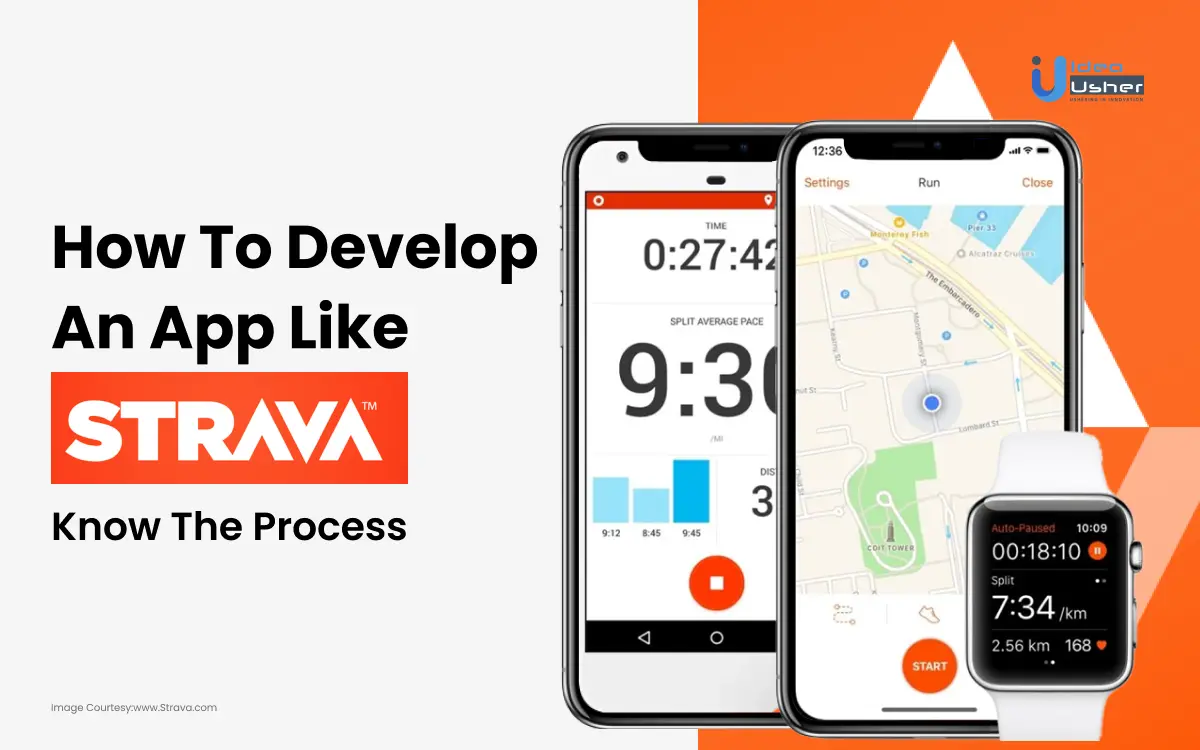
Starting a fitness journey has never been easier, thanks to the booming market of fitness apps. The convenience of achieving health goals with just a smartphone has sparked a surge in demand for fitness app development.
Strava has marked its place in the fitness app industry, especially for cyclists and those who love to stay active with friends and family. Its GPS tracking, social features, and data analytics have set the benchmark for fitness app development.
The success of apps like Strava has fueled a growing demand for similar platforms. In this guide, we’ll walk you through the essential features, the technology stack, design considerations, and marketing strategies to help develop an app like Strava.
- Fitness App Market Size
- What Is A Strava App?
- How Do Apps Like Strava Work?
- Why Fitness Apps Like Strava Are Getting Popular?
- Latest Trends To Look In For Developing An App Like Strava
- Must-Have Features In An App Like Strava
- Cost Affecting Factors To Consider To Develop An App Like Strava
- Monetization Strategies In Fitness Apps Like Strava
- How To Develop An App Like Strava?
- Top 5 Apps Like Strava In The Market Right Now
- Tech Stack To Consider To Develop An App Like Strava
- Conclusion
- FAQ
Fitness App Market Size
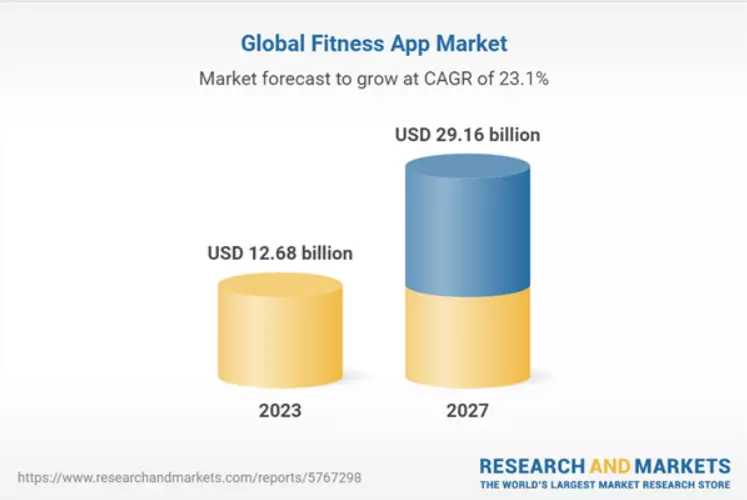
Source: Research and Markets
The expansion of the fitness app market presents a significant business opportunity, driven by the growing demand for digital health and wellness solutions.
With a global emphasis on fitness, users are seeking convenient digital platforms to manage their health. The widespread use of smartphones and wearables has further propelled this trend, establishing a large user base for fitness apps.
This growing market size not only reflects the heightened awareness of health-conscious consumers but also offers a favorable environment for entrepreneurs and businesses to tap into the changing preferences of modern fitness enthusiasts.
Businesses can capitalize on this diversity to create specialized offerings tailored to specific user needs. The integration of advanced technologies such as artificial intelligence, augmented reality, and biometric data analysis brings sophistication to these apps, enhancing their overall appeal and functionality.
What Is A Strava App?
Strava is a popular fitness and social networking application designed for athletes and fitness enthusiasts. The app primarily focuses on tracking and analyzing various outdoor activities such as running, cycling, swimming, and more. Users can record their workouts using GPS technology, capturing data like distance, speed, elevation, and route maps. Strava’s key feature is its ability to provide detailed performance metrics, allowing users to monitor their progress over time.
In addition to its tracking capabilities, Strava fosters a vibrant community aspect by enabling users to connect with friends, fellow athletes, and even professional athletes. Users can share their workout achievements, post photos, and engage in friendly competition through challenges and leaderboards.
The app also offers personalized training plans, allowing users to set goals and receive recommendations tailored to their fitness levels. Strava has become a go-to platform for fitness enthusiasts looking to enhance their training experience and connect with like-minded individuals worldwide, with its user-friendly interface and emphasis on both individual performance and community interaction.
How Do Apps Like Strava Work?
Apps like Strava work by utilizing a combination of GPS technology, sensors, and algorithms to track and analyze various fitness activities. Here’s a breakdown of the key components and processes involved:
1. GPS Tracking
One of the fundamental features of apps like Strava is GPS tracking. The app uses the GPS receiver in a user’s mobile device or connected fitness device (such as a smartwatch) to accurately determine the user’s location during an activity. This allows the app to record the route taken, calculate distance, and track changes in elevation.
2. Sensor Integration
Many modern smartphones and fitness devices come equipped with additional sensors, such as accelerometers, gyroscopes, and heart rate monitors. These sensors provide supplementary data to enhance the accuracy and richness of the recorded activity. For example, accelerometers can help detect changes in speed and movement patterns, while heart rate monitors provide insights into the intensity of the workout.
3. Data Analysis and Metrics
Once the activity is recorded, apps like Strava use sophisticated algorithms to analyze the collected data. This analysis includes calculating metrics such as distance traveled, average speed, elevation gain, and split times. These metrics provide users with valuable insights into their performance and progress over time.
4. Social and Community Features
Beyond individual tracking, apps like Strava incorporate social and community features. Users can share their activities with friends, join clubs or groups, and participate in challenges. The social aspect adds a motivational element to fitness routines and fosters a sense of community among users with shared interests.
5. Cloud Integration
To ensure data accessibility and synchronization across multiple devices, apps like Strava often employ cloud-based storage. This allows users to access their workout history, performance metrics, and other data from different devices seamlessly.
6. Personalized Features
Some fitness apps, including Strava, offer personalized features such as training plans, goal setting, and performance analysis. These features leverage the accumulated data to provide users with tailored recommendations, helping them set and achieve their fitness objectives.
Why Fitness Apps Like Strava Are Getting Popular?
Fitness apps like Strava have gained immense popularity for several reasons, contributing to their widespread adoption and success. Here are some of the notable reasons:
1. Free App Install and Flawless Workout Uploads/Run Tracking
Strava and similar fitness apps offer free downloads and easy setup, removing barriers for users to start tracking their workouts. The seamless integration with various devices ensures that users can effortlessly upload and track their runs or other activities, enhancing user experience and convenience.
2. Huge Variety of Sports to Track
Strava stands out by supporting a diverse range of sports beyond just running, including swimming, cycling, climbing, and more. This versatility appeals to a broad audience with different fitness interests, making it a one-stop solution for tracking various activities.
3. Large Scalable Community
The success of Strava is significantly attributed to its emphasis on community building. The app allows users to connect with like-minded individuals, join clubs, and participate in challenges. This sense of belonging to a larger fitness community encourages users to stay engaged and motivated in their fitness journeys.
4. Smooth Interface
The user interface of Strava is designed to be intuitive, offering a seamless and logical experience. Users can easily navigate through the app, track their activities, and access detailed analytics without facing any usability challenges. A user-friendly interface contributes to positive user experiences and encourages continued app usage.
5. Sense of community support
Strava fosters a sense of security and inclusion by bringing together individuals with similar fitness goals and interests. The ability to share activities with the community provides a supportive environment where users can receive encouragement, advice, and motivation. This social aspect enhances the overall user experience and contributes to the app’s popularity.
Latest Trends To Look In For Developing An App Like Strava
From AI-powered training programs to augmented reality workouts, these trends reflect a commitment to innovation and enhanced engagement, catering to a diverse range of user preferences and advancing holistic well-being.
1. AI-enhanced training Programs
One prominent trend is the integration of artificial intelligence (AI) into training plans. These AI-powered programs analyze individual fitness levels, objectives, and performance data to deliver personalized workouts, ensuring more effective and tailored training experiences.
2. Immersive Augmented Reality (AR) Workouts
A rising trend in fitness cycling apps involves the integration of augmented reality (AR) for enhanced user engagement. AR features, gaining momentum, create immersive experiences like virtual cycling routes, injecting motivation and interactivity into indoor training sessions.
3. Seamless Integration with Smart Equipment
Fitness cycling apps are increasingly aligning with smart cycling equipment, such as smart trainers and connected bikes. This integration facilitates real-time data exchange, enabling features like terrain-based resistance adjustments and advanced performance tracking.
4. Social and Gamification Elements
To cultivate community engagement and motivation, fitness cycling apps are incorporating social and gamified components. Users can partake in virtual group rides, challenge friends, earn rewards, and share achievements, fostering an interactive and enjoyable environment.
5. Wearable Device Integration
Continued emphasis on seamless integration with wearable devices, including smartwatches and fitness trackers, remains a pivotal trend. This ensures users can effortlessly monitor and analyze cycling performance metrics directly through the app interface.
6. Live Streaming and On-Demand Class Accessibility
The surging demand for live streaming and on-demand cycling classes is reshaping fitness cycling apps. Users can access real-time classes led by instructors or explore a library of pre-recorded sessions, and catering to diverse preferences and schedules.
7. Holistic Nutrition and Wellness Features
Many fitness cycling apps are expanding their offerings to include nutrition and wellness features. Users can track dietary habits, receive nutritional guidance, and access wellness content to complement their cycling routines.
8. Virtual Challenges and Global Competitions
Virtual challenges and competitions are gaining popularity within fitness cycling apps. These features empower users to set personal challenges, participate in virtual races, and compete with cyclists globally, injecting excitement and friendly competition.
9. Advanced Biometric Data Analysis
The integration of advanced biometric data analysis is enriching the insights provided by fitness cycling apps. Users can delve into detailed analytics of their performance, including recovery metrics, fatigue analysis, and personalized recommendations for optimizing training schedules.
10. Subscription Models Offering Premium Content
A prevalent strategy in the fitness cycling app market involves the adoption of subscription-based models offering premium content. This includes exclusive training programs, in-depth analytics, and additional interactive elements, delivering users a more comprehensive and value-added experience.
Must-Have Features In An App Like Strava
In the ever-changing field of fitness applications, integrating vital functionality is critical to success. Explore the must-have features that enhance apps like Strava, increasing user engagement and overall efficacy.
1. GPS Tracking for Real-Time Data
Integrate powerful GPS tracking features, a fundamental component of activity tracker software, especially for sports involving long distances. Similar to fitness apps like Strava, provide users with real-time information on routes, speeds, and generate trajectories displayed on a map. Whether developing for Android, iOS, or other platforms, GPS tracking is a crucial feature that should not be overlooked.
2. Diverse Activity Tracking
Offer users the flexibility to track various sports and activities within the app. While Strava focuses on specific sports, your app can stand out by allowing users to monitor different activities, providing details such as time spent, total calories burned, and user vitals during workouts. Advanced analytics for certain sports can further assist users in improving their performance.
3. Calorie Burn Tracking
Ensure the incorporation of calorie burn tracking as a feature in your Strava-like running app. While commonly found in activity trackers, enhancing user confidence by providing this feature is essential. Consider going beyond the basics by integrating additional features like sleep tracking, creating a unique and comprehensive experience not widely offered in the current market.
4. Multi-Device Compatibility
Maximize your app’s reach by ensuring compatibility with various devices and fitness trackers. While challenging for those opting for a DIY approach in fitness app development, hiring professionals can streamline the process. Incorporating multi-device compatibility adds significant value to the app and requires specialized expertise.
5. Business Analytics for User Recommendations
Implement in-depth analytics to offer users personalized recommendations for enhancing their workouts and activities. Utilize the gathered analytics to guide the app’s development in a user-focused direction, resulting in increased engagement and an improved user experience. For cycling apps like Strava, integrating business analytics is a strategic move.
Cost Affecting Factors To Consider To Develop An App Like Strava
The cost to develop an app like Strava will depend on various factors. Each factors plays their crucial role in determining the overall cost required to create an fitness app like Strava.
1. Feature Set and Complexity
The development cost of an app resembling Strava is tied to the chosen features and their complexity. Strava, recognized for its extensive suite including GPS tracking, route planning, social networking, and performance analytics, demands intricate development.
The more intricate and diverse the features, the higher the associated development costs. Thoughtful selection of essential features and a phased development approach aids in managing costs while preserving core functionality.
2. Platform and Device Compatibility
Development costs are significantly influenced by the choice of platforms and devices. Crafting a cross-platform app compatible with both iOS and Android entails additional effort compared to focusing on a single platform.
Moreover, tailoring the app for various devices, including smartphones, tablets, and wearables, introduces complexities impacting overall development costs. Decisions related to platform selection must align with the target audience to ensure cost-effective development.
3. Mapping and GPS Integration
Strava’s fundamental reliance on mapping and GPS integration for precise activity tracking underscores the cost-intensive nature of implementing robust mapping features. This complexity is amplified when incorporating advanced mapping technologies. The accuracy, real-time updates, and seamless integration with GPS APIs contribute significantly to the overall app cost.
4. User Interface (UI) and User Experience (UX) Design
Investment in a well-crafted UI/UX design enhances user engagement but requires skilled designers and additional development time. The complexity of the design, encompassing interactive maps, charts, and social features, influences costs. Achieving a balance between aesthetics and functionality is essential for effectively managing development expenses.
5. Social and Community Features
The cost of implementing social features encompasses server infrastructure, data storage, and real-time communication systems. Decisions regarding the scope of social functionality impact development costs and ongoing maintenance.
6. Security and Privacy Measures
Implementing robust security measures, secure data transmission, and compliance with privacy regulations contribute to additional development costs. Balancing security and user convenience is crucial, and investments in cybersecurity measures can help avoid potential breaches, preventing reputational damage and legal consequences.
7. Third-Party Integrations
The inclusion of third-party integrations, such as fitness device compatibility, health data APIs, and external mapping services, affects development costs. Strava’s integration with various devices expands functionality. However, each integration demands careful implementation, testing, and ongoing maintenance.
Evaluating the necessity of third-party integrations and their impact on the user experience is essential for managing development expenses.
8. Scalability and Performance Optimization
Strategic planning for scalability and optimizing app performance significantly influences development costs. Strava’s handling of a substantial volume of user-generated data necessitates a robust infrastructure for scalability.
Implementing features like real-time updates, data synchronization, and efficient backend architecture impacts development costs. Designing the app for effective scaling is crucial for managing ongoing maintenance and operational costs.
9. Regulatory Compliance
Ensuring compliance with regulations such as GDPR or HIPAA may require additional development efforts and ongoing monitoring. Non-compliance can result in legal consequences and reputational damage, emphasizing the importance of budgeting for regulatory compliance measures.
10. Testing and Quality Assurance
Thorough testing and quality assurance are pivotal components of app development influencing costs. Testing across various devices, platforms, and user scenarios adds to development costs but is crucial for delivering a bug-free and seamless user experience. Balancing testing efforts with project timelines is essential for cost-effective development.
Monetization Strategies In Fitness Apps Like Strava
By strategically combining these monetization strategies, businesses can create a sustainable business model while delivering value to their users.
1. Freemium Model
The freemium model is a widely adopted strategy in fitness app development, allowing users to access a basic version of the app for free while offering premium features at a subscription cost. For instance, users may get basic workout tracking and social sharing for free, but upgrading to the premium version unlocks advanced analytics, personalized training plans, and exclusive content.
2. Subscription Model
Implementing a subscription-based model involves offering users premium content, personalized plans, or an ad-free experience in exchange for a recurring fee. This model creates a consistent revenue stream, enabling businesses to enhance and maintain the app continually. Subscriptions provide financial stability, allowing developers to allocate resources for ongoing improvements.
3. In-App Purchases
In-app purchases present an opportunity to diversify revenue streams by allowing users to buy additional content, workout plans, or nutrition guides. These microtransactions offer a scalable way to cater to individual user needs, creating a personalized experience while contributing to the app’s financial sustainability.
4. Ad-Based Monetization
Ad-based monetization involves displaying advertisements within the app, generating revenue through impressions, clicks, or video views. To ensure a positive user experience, it’s essential to place non-intrusive ads strategically and, if possible, personalize them based on user preferences, making them more engaging and relevant.
5. Affiliate Marketing
Incorporating affiliate marketing involves partnering with fitness-related brands and promoting their products or services within the app. By earning commissions for successful referrals or sales, businesses can capitalize on mutually beneficial relationships, aligning app content with users’ fitness-related interests.
How To Develop An App Like Strava?
Building a Strava-like app needs an organized approach that combines unique features and smooth functioning. Understand the key steps to create a successful app like Strava.
1. Conduct Comprehensive Research
Start by conducting thorough research on the fitness app market and analyze competitors like Strava. Identify their features, strengths, weaknesses, and user feedback. Gathering this information is crucial for creating a competitive and appealing fitness app. Take notes and use this data during the development process.
2. Build a Minimum Viable Product (MVP)
Prioritize the creation of a Minimum Viable Product (MVP) before proceeding to the final version. An MVP allows you to test essential features, gather user feedback, and identify potential improvements. This step ensures that you develop a robust and error-free fitness app that aligns with your business goals.
3. Focus on UX/UI Design
Design plays a pivotal role in user engagement. Aim for a sleek and intuitive user interface (UI) and user experience (UX) to captivate users. Strive for simplicity, avoiding confusion or frustration. Consider hiring dedicated developers and designers to ensure a unique and visually appealing app design.
4. Implement Strong Security Measures
Prioritize security by incorporating robust protocols to protect user data and privacy. Ensure encryption of shared data and conduct thorough testing to identify and address security flaws. Regardless of unique features, a lack of security can undermine the success of your fitness app.
5. Incorporate Unique Features
Distinguish your fitness app by including unique features and functionalities. Brainstorm and select features that add significant value to your application. Refer to insights provided by fitness app developers to determine the most relevant and innovative features for your app.
6. Choose a Reliable Development Partner
Select a trustworthy fitness app development company with experienced developers, designers, and testers. Outsourcing can be cost-effective while ensuring professional expertise. Inquire about the mobile app development cost to manage your budget effectively.
7. Test and Launch Your Fitness App
Thoroughly test your feature-rich fitness application to identify and eliminate errors and bugs. Users are less likely to use an app with performance issues. Consider hiring experienced quality analysts and testers to ensure a smooth and error-free launch. Once testing is complete, launch your app on the desired platform.
Top 5 Apps Like Strava In The Market Right Now
In this section, explore the top five cycling apps revolutionizing the way cyclists interact with their rides and enhance their overall biking experience.
1. MapMyRide
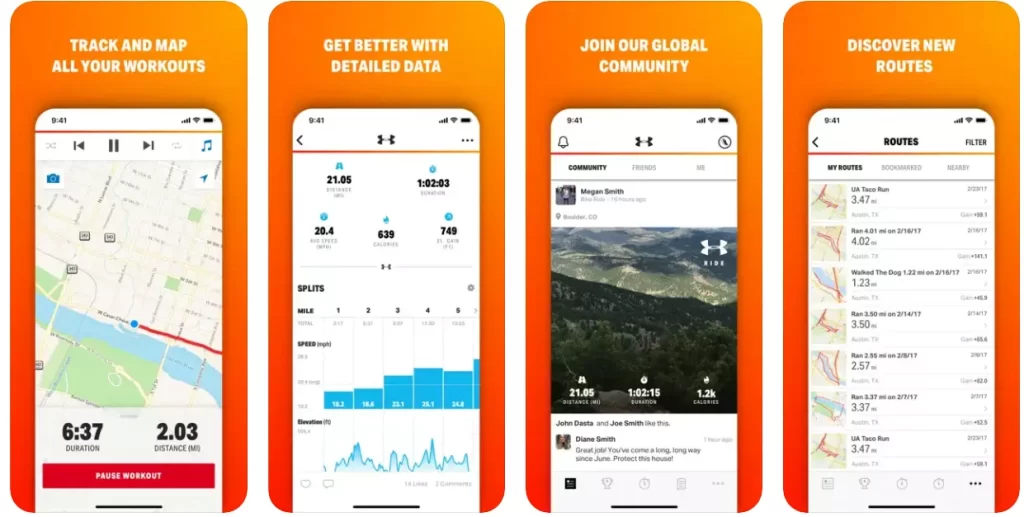
MapMyRide is a popular fitness app designed for cyclists to track and analyze their biking activities. Developed by Under Armour, it serves as a comprehensive platform that enables users to map out their riding routes, monitor performance metrics, and engage in a supportive community of fellow cyclists. The app utilizes GPS technology to record the distance, duration, speed, and elevation of each ride, providing users with detailed insights into their biking achievements.
Additionally, MapMyRide offers features such as route planning, goal setting, and the ability to share rides with the community, fostering a social and motivational environment for cyclists of all levels. Overall, MapMyRide caters to the biking community by combining technological tracking capabilities with a social platform to enhance the overall cycling experience.
2. BikeMap

BikeMap is a location-based platform designed to enhance the biking experience by providing cyclists with a comprehensive mapping and navigation solution. The platform allows cyclists to plan, discover, and share biking routes, leveraging mapping technologies to offer detailed insights into terrain, elevation, and points of interest along the way.
Users can create personalized biking routes based on their preferences, such as scenic views, challenging terrains, or specific distances, making it a versatile tool for both recreational cyclists and serious biking enthusiasts. The app aims to foster a community of cyclists by facilitating the exchange of route recommendations and fostering a sense of exploration and connectivity within the biking community.
3. Komoot
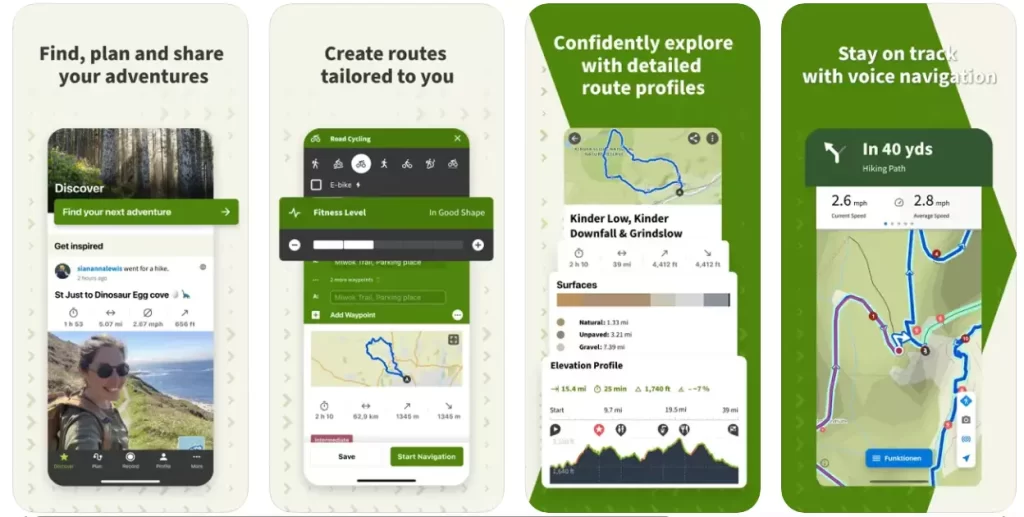
Komoot utilizes the open-source OpenStreetMap database, offering users the capability to plan various types of rides, including road, mountain bike, gravel, and daily commutes. The app prioritizes efficiency by considering the bike-friendliness of roads or paths and the user’s fitness level. By inputting start and end points, Komoot provides information on route difficulty, required fitness levels, road surfaces, and presents an elevation profile.
During a ride, Komoot offers real-time metrics such as speed, distance covered, remaining distance, and enables users to make on-the-fly route adjustments effortlessly. Additionally, users can explore other recommended routes in their local area and benefit from curated highlights suggested by local riders and Komoot ambassadors, providing insights into hidden gems.
Komoot’s premium subscription enhances the experience with extra features like a multi-day planner and live tracking, providing users with comprehensive tools to optimize their cycling adventures.
4. RidewithGPS
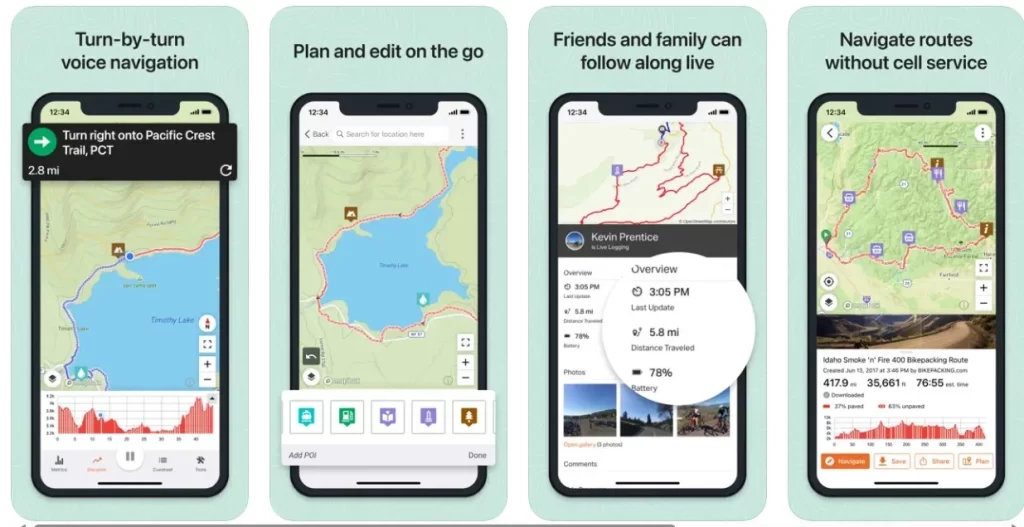
RidewithGPS stands out as a versatile application for detailed route planning, navigation, and ride recording. With a user-friendly interface, the app simplifies the recording process with a single tap, offering the convenience of offline navigation – a valuable feature for remote or extended rides where battery preservation is crucial.
The app provides comprehensive route data, including detailed elevation profiles that users can zoom in and out of, allowing them to pinpoint the locations of significant climbs along the route. Sharing real-time rides is made easy, with an added feature that reads aloud comments for an extra motivational boost during cycling sessions.
In its free version, the app enables users to create routes, record rides, and set personal goals. The Basic subscription offers additional mobile app features such as turn-by-turn navigation, live logging, and offline mapping, along with the ability to publish ride reports. For an enhanced experience, the Premium version includes advanced route editing, custom cue sheets, support for stationary bikes, and access to private segments.
5. Elite HRV
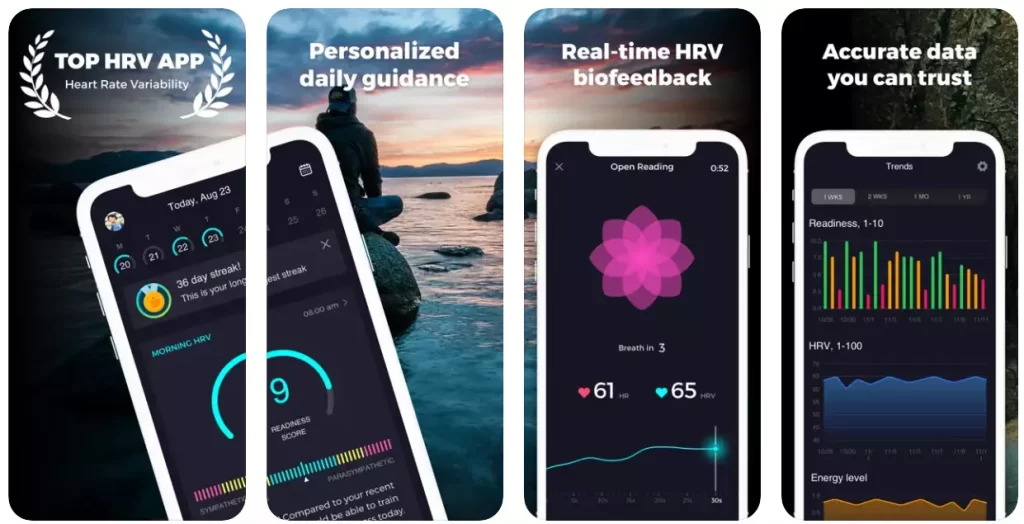
For individuals seeking additional data and metrics in their daily lives, the Elite HRV app presents a convenient solution for monitoring heart rate variability (HRV). HRV data, obtained with a compatible Bluetooth heart rate monitor like the Polar H10 heart rate strap, serves as a valuable marker for assessing training recovery and readiness for increased training loads. The app allows users to track HRV for free, offering unlimited data storage, provided they have a compatible device listed on Elite HRV’s website.
Users can enhance the context of their HRV readings by tagging each entry with relevant information such as mood, stress levels, and recent activity. While the app offers paid plan with more advanced insights and readiness information, the free version provides a user-friendly and informative introduction for those interested in incorporating HRV as a training aid.
Tech Stack To Consider To Develop An App Like Strava
Creating an app like Strava requires the use of a diverse range of tools to handle various areas of the development process. The following are recommended tech stack in the development of fitness and tracking applications:
1. Programming Languages
- Swift (iOS)
- Kotlin/Java (Android)
2. Integrated Development Environments (IDEs)
- Xcode (iOS)
- Android Studio (Android)
3. Cross-Platform Development Frameworks
- React Native
- Flutter
- Xamarin
4. Backend Development
- Node.js
- Django
- Flask
5. Database Management
- Firebase
- MongoDB
- MySQL
6. GPS and Mapping Services
- Google Maps API
- Mapbox
7. User Authentication
- Firebase Authentication
- OAuth
8. Real-Time Communication
- Socket.io
- Firebase Realtime Database
9. Cloud Services
- AWS
- Google Cloud Platform
10. Version Control
- Git
- GitHub
- Bitbucket
11. Testing and Debugging
- XCTest (iOS)
- Espresso (Android)
- Junit
- Appium
12. Continuous Integration/Continuous Deployment (CI/CD)
- Jenkins
- Travis CI
- CircleCI
13. App Performance Monitoring
- Firebase Performance Monitoring
- New Relic
14. Collaboration and Communication
- Slack
- Trello
- Jira
15. Analytics
- Google Analytics
- Mixpanel
Conclusion
Strava stands out as a highly successful fitness application, achieving significant popularity in a relatively short period. This success has encouraged numerous business owners to consider developing apps similar to Strava. With a comprehensive understanding of Strava app development, the next step involves initiating the mobile app development process.
Start with the creation of the Minimum Viable Product (MVP) and progress to the final product after incorporating necessary elements and conducting thorough quality checks. For optimal results, businesses can seek guidance from a leading fitness app development company, leveraging the expertise of experienced professionals to craft a bespoke application tailored to their specific business requirements.
Reach out to our team for the creation of an app similar to Strava. Our developers will identify your company’s needs and implement cutting-edge technology, incorporating industry best practices.
Our goal is to craft a digital fitness platform that is not only user-friendly but also scalable and secure. Get in touch with us to explore how our fitness development services can contribute to the establishment and expansion of your business.
FAQ
Q. What is a Strava app?
A. Strava, a well-known fitness app, stands out for its global appeal in tracking and analyzing diverse physical activities. Strava is the preferred choice for cyclists, runners, and fitness enthusiasts seeking to track and share their workouts with offering features such as GPS tracking, social interaction, and performance analytics and others.
Q. What are the top 5 cycling apps like Strava?
A. MapMyRide, BikeMap, Komoot, RidewithGPS and Elite HRV are some of the best cycling apps like Strava.
Q. What Is the cost for Strava similar app development?
A. The cost to develop an app similar to Strava will depend on several factors such as feature set and complexity, platform and device compatibility, mapping and GPS integration, social and community features, security and privacy measures, third-party integrations, scalability and performance optimization, and regulatory compliance.
Q. How to develop an app like Strava?
A. To create an app like Strava, start by identifying key features such as GPS tracking, social engagement, and performance analytics. choose a robust technology stack, ensuring scalability and security. Design an intuitive user interface, focusing on user experience. Finally, implement effective marketing strategies to promote your fitness app and attract a dedicated user base.







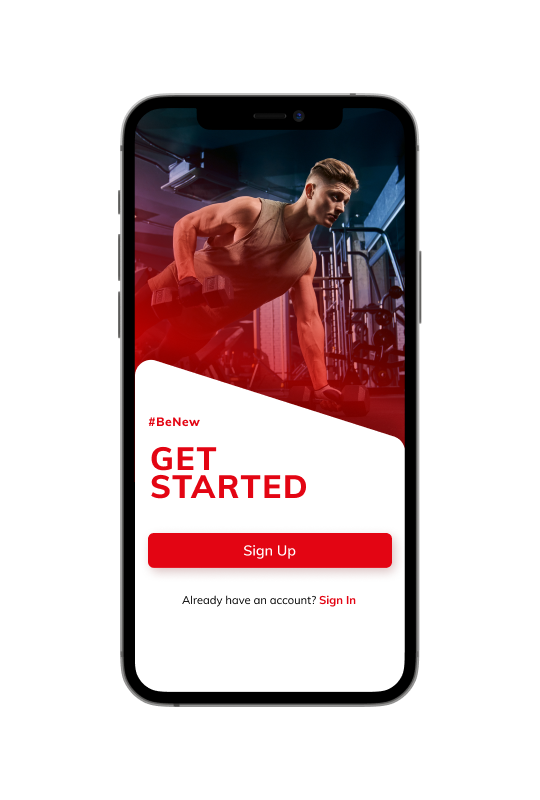


Gaurav Patil